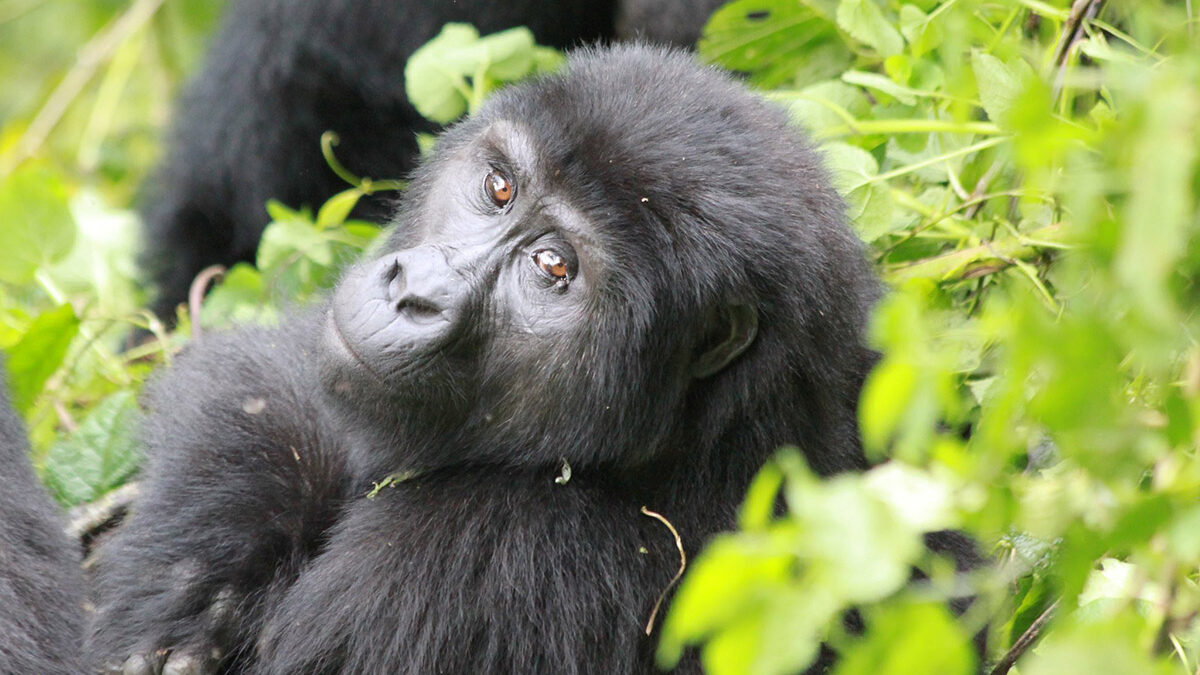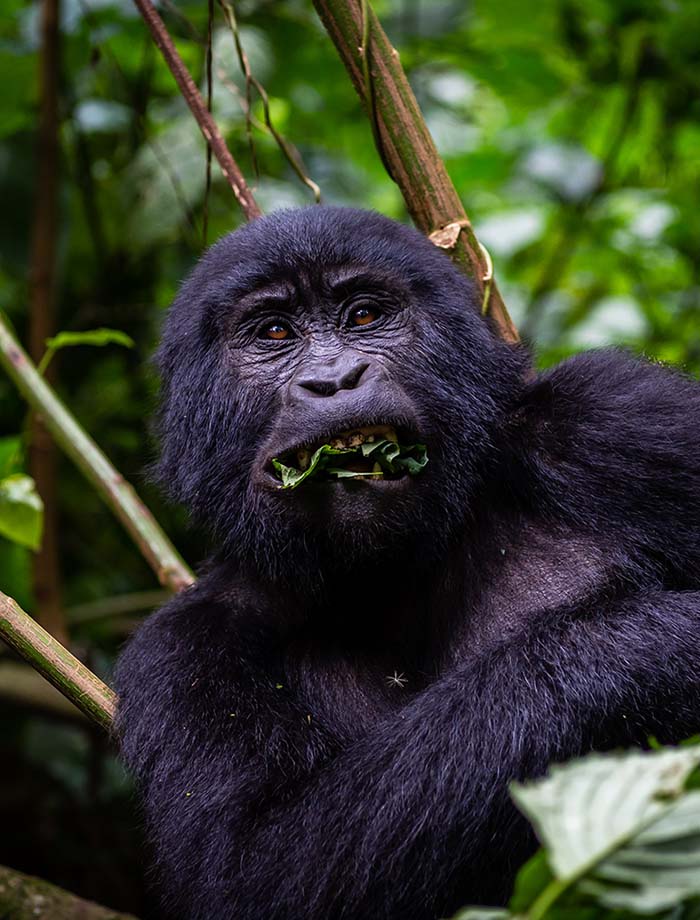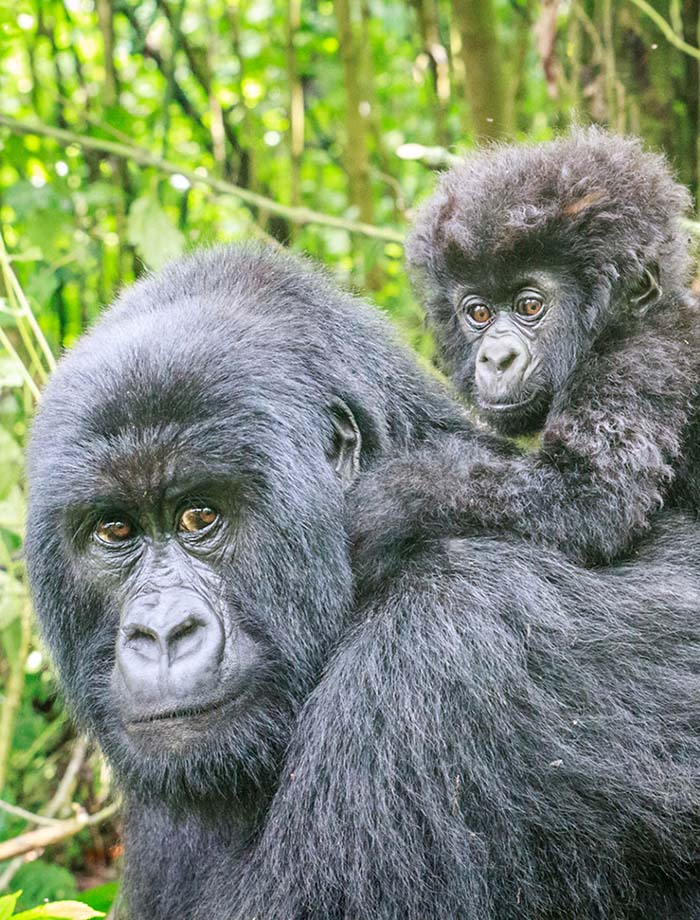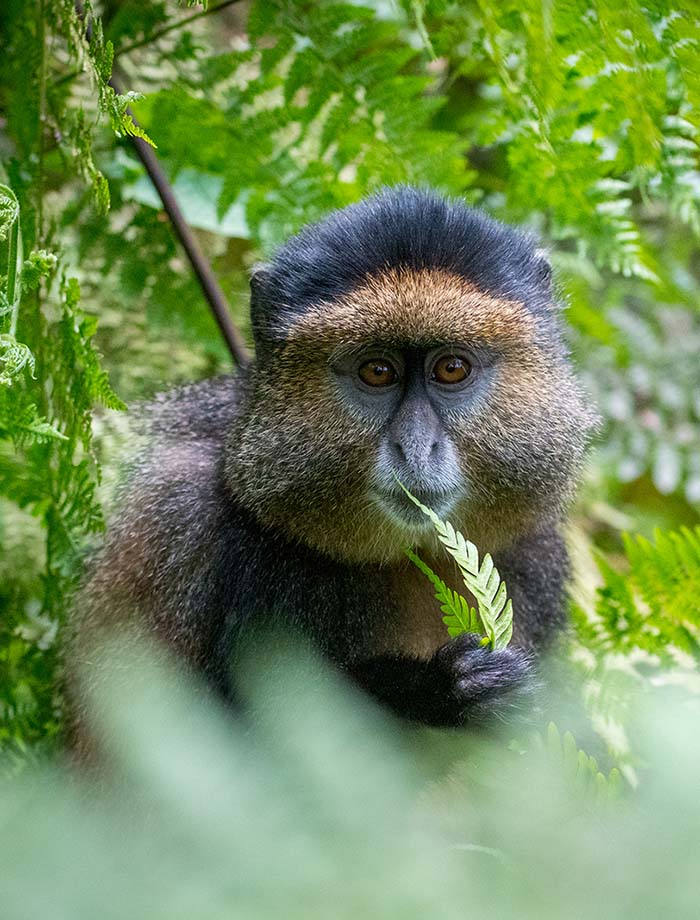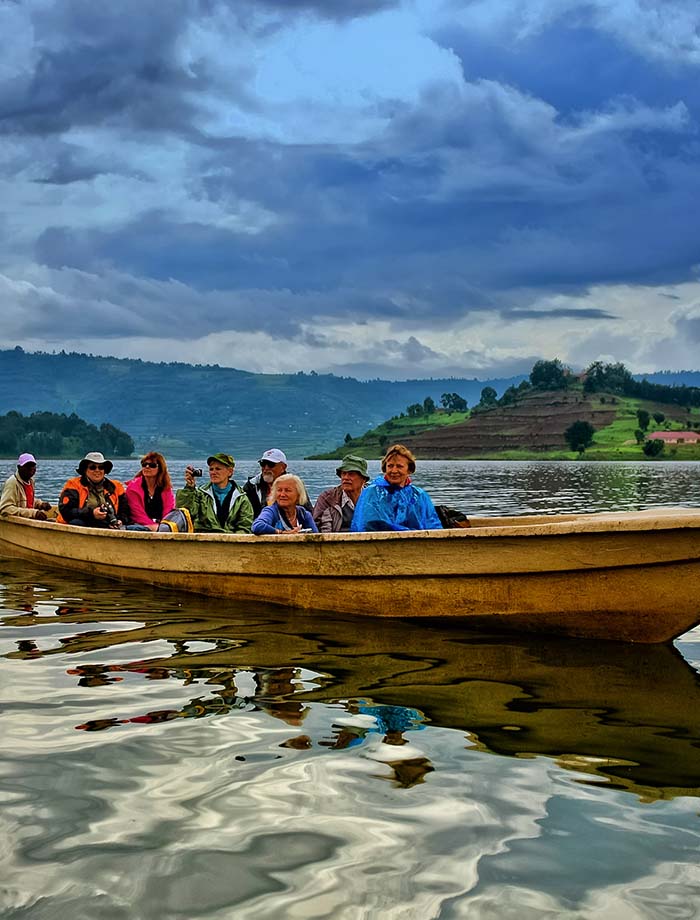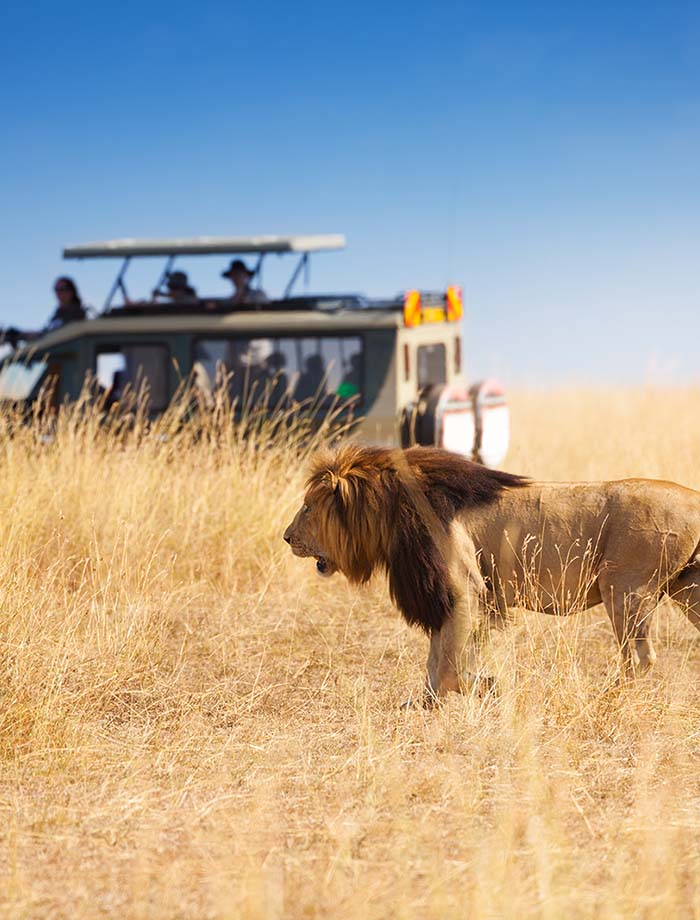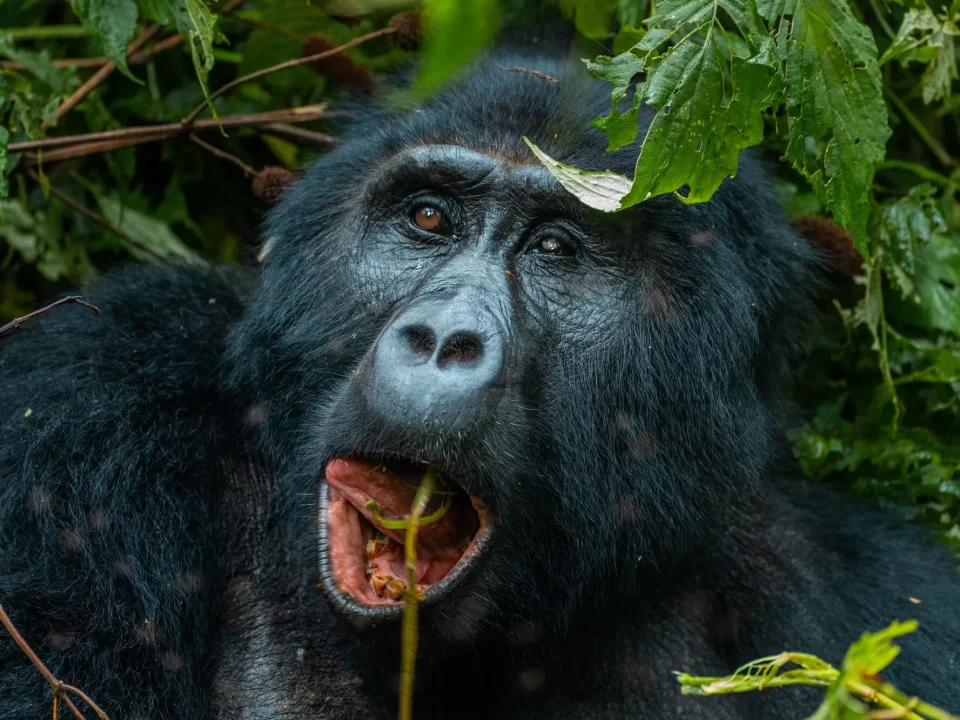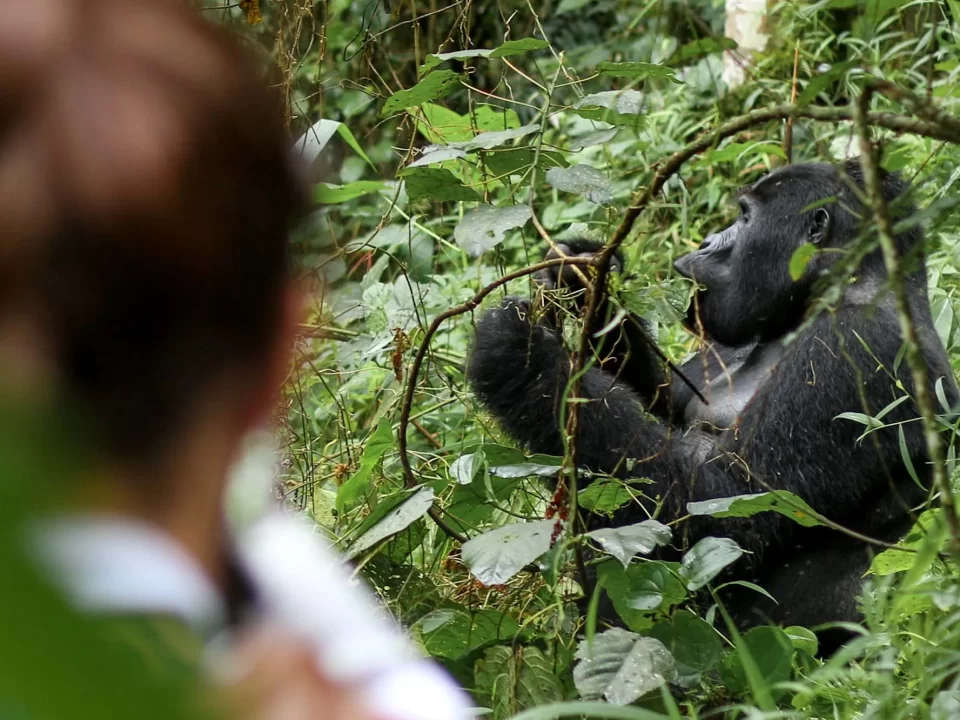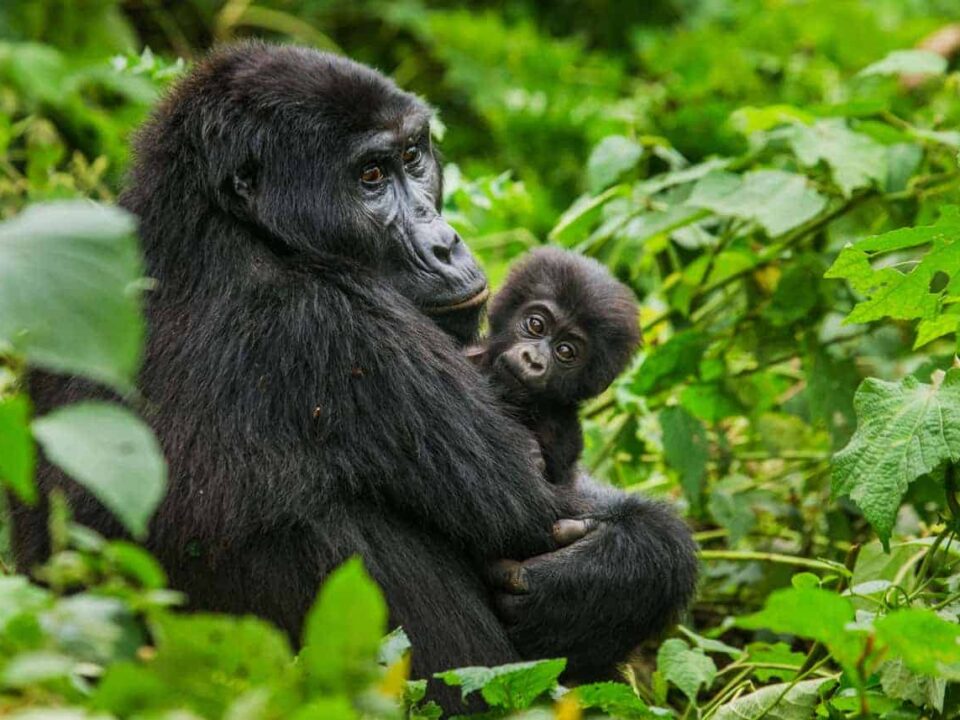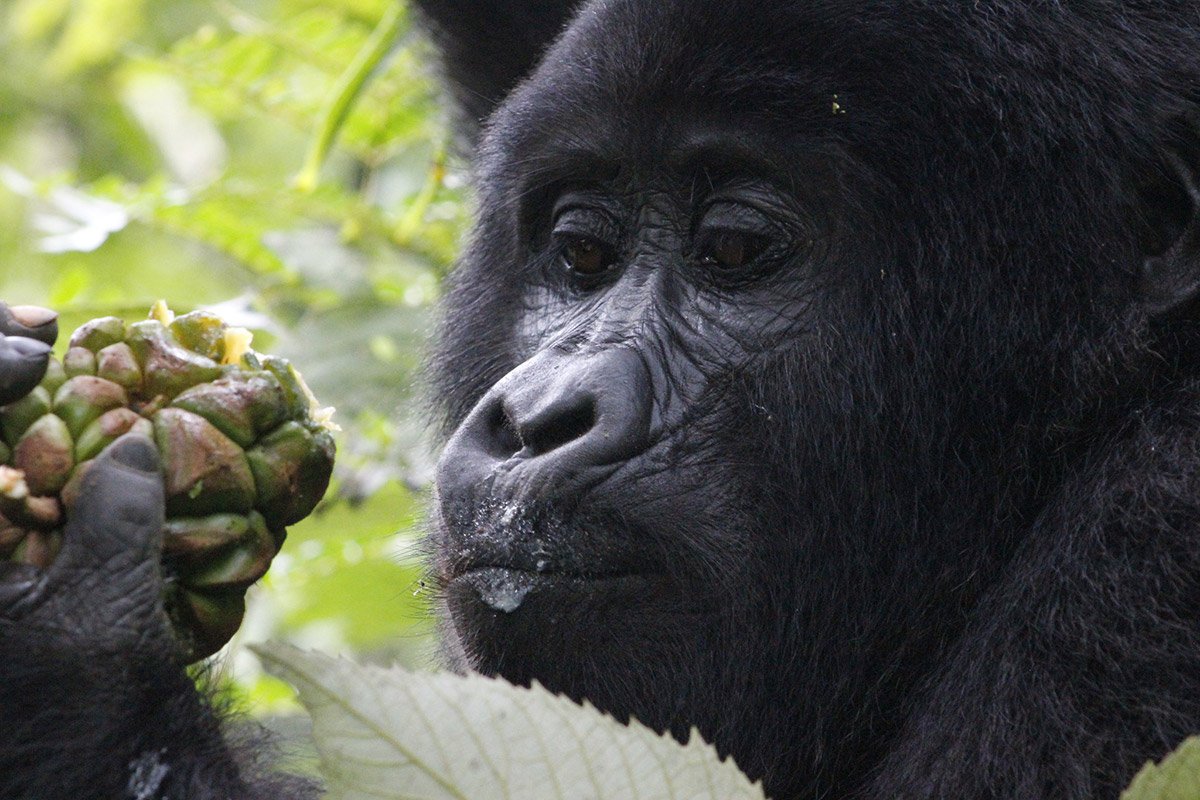
Gorilla Trekking in Rwanda vs Uganda
May 20, 2020Facts About Mountain Gorillas: Conservation, Behavior, and More
Fascinating Facts About Mountain Gorillas — Seeing the mountain gorillas in person is an experience like no other. While reading about them is fascinating, nothing compares to spending an hour (or even up to four hours in Uganda’s Gorilla Habituation Experience) with these incredible creatures in their natural habitat. This unique experience not only allows you to witness these majestic beings up close but also plays a vital role in their conservation. The fees from gorilla trekking permits directly contribute to protecting these endangered animals and support local communities, creating a sustainable model for both wildlife and people.
Mountain gorillas can only be found in a few remote areas of Central Africa: Uganda, Rwanda, and the Democratic Republic of Congo. In these countries, visitors can safely engage in gorilla trekking, a once-in-a-lifetime experience that lets you look into the eyes of one of the world’s most endangered great apes.
The Mountain Gorilla’s Habitat and Population
The mountain gorilla is an endangered species with a population estimated at fewer than 1,063 individuals, based on the latest census. Half of these gorillas reside in Uganda, making the country a prime destination for gorilla trekking. Bwindi Impenetrable National Park, with its dense, misty forests, is home to approximately 400 gorillas, while Mgahinga Gorilla National Park in the southwestern corner of Uganda hosts 80 gorillas. These gorillas frequently roam between Uganda, Rwanda, and the Democratic Republic of Congo, forming an international bond of wildlife.
Uganda is home to 480 mountain gorillas spread across 39 families or groups, though only 13 of these families have been habituated for trekking. The habituation process is essential for allowing visitors to safely observe these gorillas without disturbing their natural behavior.
Conservation Efforts and the Role of Rwanda
Rwanda is a global leader in the conservation of mountain gorillas, with around 320 individuals thriving in the country’s Volcanoes National Park. This success story can be largely attributed to the pioneering work of American zoologist Dian Fossey, whose research in the 1960s laid the foundation for ongoing conservation efforts. Although Fossey’s life was tragically cut short in 1985, her work continues to inspire and shape the country’s conservation strategies.
Today, Rwanda stands at the forefront of mountain gorilla conservation, leveraging tourism as a critical tool for funding these initiatives. The revenue from gorilla trekking permits directly supports essential conservation activities, including anti-poaching efforts, habitat restoration, and local community development projects. This sustainable tourism model not only offers visitors a once-in-a-lifetime opportunity to observe gorillas in their natural habitat but also contributes to the preservation of these endangered creatures and the well-being of surrounding communities.
As a result of these dedicated conservation efforts, Rwanda has become one of the top destinations for gorilla trekking. Visitors have the unique chance to get up close to mountain gorillas while actively contributing to their protection. However, due to ongoing political instability in the Democratic Republic of Congo, trekking in Virunga National Park has been temporarily suspended. This has made Rwanda, along with Uganda, the most reliable and safe options for experiencing this unforgettable wildlife adventure.
Gorilla Trekking Rules and Regulations
Whether you’re trekking in Uganda or Rwanda, the rules for gorilla trekking are the same to ensure the safety and well-being of the gorillas and the visitors. Each trekking group is limited to just 8 people per day, minimizing the impact on the gorillas and reducing stress on the animals. Visitors are allowed a maximum of one hour with the gorillas, ensuring that the experience remains intimate yet respectful.
Gorilla families that are habituated to human presence are specifically chosen for trekking. These gorillas have become accustomed to the presence of tourists and are not disturbed by their observations. This is essential for maintaining the natural behavior of the gorillas while still offering an extraordinary opportunity for visitors to get close and learn about them.
The Mountain Gorilla Families of Uganda
Uganda is home to 24 habituated gorilla groups, spread across the Bwindi Impenetrable National Park and Mgahinga Gorilla National Park. These families include:
-
Buhoma Section: Mubare, Habinyanja, Katwe Family, Binyindo Family and Rushegura families
-
Ruhija Section: Bitukura, Kyaguriro Family, Mukiza Family and Oruzogo families
-
Nkuringo Section: Nkuringo family, Bushaho Family, Christmas Family, Posho Family and Tindatine Family
-
Rushaga Area: Nshongi, Mishaya, Kahungye, Bweza, and Busingye families, Mucunguzi Family, Rwigi Family, Bikingi Family, Kutu Family
-
Mgahinga Gorilla National Park: Nyakagezi family
The Nyakagezi family is particularly interesting as it often roams across the borders of Uganda, Rwanda, and Congo. However, after the birth of a baby gorilla, the family decided to settle on the Ugandan side.
Additionally, the Kyaguriro family in the Ruhija area is set aside for research purposes, allowing scientists to study gorilla behavior and better understand their needs and habits. This research contributes to the ongoing conservation efforts and the future of the species.
Discover the Mountain Gorilla Families of Rwanda
Rwanda is home to 12 mountain gorilla families, with a daily limit of up to 80 permits for visitors to experience these incredible creatures. These gorilla families live in the lush, volcanic slopes of the Volcanoes National Park, and each one has its own unique story and characteristics.
The Susa Family, originally studied by renowned primatologist Dian Fossey, inhabits the slopes of Mount Karisimbi. Nearby, you’ll also find the Susa B Family (also known as the Karisimbi family), which broke away from the original Susa group. The Sabinyo Family, known for being the smallest and most easily accessible, resides on the slopes of Mount Sabinyo. The Amahoro Family, often referred to as the most peaceful of all, can be found in the park, as well as the Umubano Family, which separated from Amahoro.
Other notable families include the Agashya Family (also known as the 13 Group), the Kwitonda Family, the Hirwa Family, the Bwenge Family, and the Ugenda Family. Together, these families form a unique part of Rwanda’s rich natural heritage, allowing visitors to explore the “Land of a Thousand Hills” through intimate and unforgettable gorilla trekking experiences.
The Mountain Gorilla: A Rare and Endangered Species
Mountain gorillas are one of the most captivating creatures on the planet. These strong, large apes live on the volcanic slopes of Africa’s mountain regions, primarily in the protected national parks of Uganda, Rwanda, and the Democratic Republic of Congo. Despite their formidable size and strength, mountain gorillas have few natural predators. However, due to human activities such as poaching, habitat destruction, and civil unrest, these gorillas have become one of the most endangered species in the world.
Today, the mountain gorilla’s habitat is confined to a few protected areas. One group resides in Uganda’s Bwindi Impenetrable National Park, while others are spread across the Virunga Mountains, which border Uganda, Rwanda, and the Democratic Republic of Congo.
Behavior and Social Structure of Mountain Gorillas
Mountain gorillas are known for being gentle and shy, but when threatened, they can display surprising aggression. They may beat their chests, grunt, and roar, signaling their displeasure. In times of danger, the group’s alpha male, or silverback, will charge at the threat, and mothers will fight fiercely to protect their young.
Living in groups of up to 30 members, mountain gorillas form close-knit family units. Each group is led by a dominant silverback, a mature male who is responsible for the safety and well-being of the troop. These silverbacks typically develop a silver stripe on their backs as they mature, giving them their name. The oldest silverbacks are usually at least 12 years old and play a crucial role in managing the group’s daily activities, including feeding, resting, and travel.
Reproduction and Lifespan of Mountain Gorillas
Female mountain gorillas typically become mothers around the age of 10. They give birth to one or two babies after a gestation period of about 8.5 months. Throughout their lifetime, females usually have between two and six offspring.
Newborn gorillas are small, weighing around 1.8 kg (4 lb), and are similar to human infants in their weakness and lack of coordination. For the first few years, the baby gorilla stays close to its mother, clinging to her back as she moves. By the age of 3.5 years, the young gorilla is weaned and starts eating a diet similar to that of adult gorillas: leaves, plants, roots, and shoots.
Physical Characteristics of Mountain Gorillas
Fully grown male mountain gorillas can reach up to 180 kg (400 lb), while females weigh around half that, at approximately 90 kg (200 lb). Aside from the silver stripe on their backs, male gorillas have a crest of fur on their heads, which differentiates them from females. Both males and females are covered in thick black fur, which helps them stay warm in the cold, mountainous temperatures.
Mountain gorillas are powerful, yet peaceful creatures that have captivated the attention of wildlife enthusiasts and conservationists around the world. Their conservation is crucial, and visitors who engage in gorilla trekking experiences are directly contributing to efforts that help protect these incredible animals and their fragile habitat.
1. Gorillas Share Over 98% of Their DNA with Humans
Gorillas are remarkable primates, sharing more than 98% of their DNA with humans. This close genetic connection makes them one of our closest living relatives in the animal kingdom.
2. Mountain Gorillas Are Found Only in Africa, Split Across Two Populations
Mountain gorillas are native to the volcanic mountains of East Africa. One population resides in three national parks: Mgahinga Gorilla National Park in southwest Uganda, Volcanoes National Park in northwest Rwanda, and Virunga National Park in the eastern Democratic Republic of Congo (DRC). The second population is found in Uganda’s Bwindi Impenetrable National Park, offering a unique experience for wildlife enthusiasts.
3. Some Experts Consider the Bwindi Population a Separate Subspecies
While there is ongoing debate among primatologists, some believe the mountain gorillas in Bwindi may represent a distinct subspecies. However, no conclusive evidence has been presented to support this theory.
4. Mountain Gorillas Are Shy but Powerful Creatures
Mountain gorillas are known for their gentle nature, but they can become aggressive if they feel threatened. While they may never chase you if you’re looking them in the eye, they will defend themselves fiercely. They beat their chests, roar, and, if necessary, charge at intruders. Mothers are especially protective of their young and will fight to the death to keep them safe.
5. Mountain Gorillas Live in Social Groups of Up to 30 Individuals
A typical mountain gorilla group, or troop, can include up to 30 members. These groups are led by a dominant silverback, with several younger males, adult and juvenile females, and infants in the mix. The largest recorded gorilla family was in Rwanda and was led by Cantsbee, the oldest known mountain gorilla, who lived to the remarkable age of 38.
6. Silverback Gorillas Are Named for the Silver Stripe on Their Backs
Silverbacks are adult male gorillas who develop a silver stripe on their backs as they mature, a feature that gives them their name. This silver hair is similar to the graying hair humans get as they age.
7. The Silverback: Protector and Leader of the Gorilla Family
Silverback gorillas play a vital role in the group. Not only do they protect their family members from threats, but they also manage the group’s activities. They decide when to eat, rest, and travel, and they are responsible for fathering most of the offspring in the group.
8. Female Gorillas Begin Reproducing at Around Age 10
Female mountain gorillas typically start reproducing at around 10 years old. They give birth to one or two babies after a gestation period of 8.5 months. In their lifetime, they generally have between two and six offspring, ensuring the survival of their species.
Fascinating Facts About Mountain Gorillas
-
Mountain gorillas are critically endangered, with only about 900 remaining in the wild. They can only be found in Uganda, Rwanda, and the Democratic Republic of Congo.
-
With 98% genetic similarity to humans, gorillas are our close relatives, sharing many emotional traits.
-
Male gorillas can weigh up to 400 pounds, while females average around 200 pounds.
-
Gorillas are capable of expressing human-like emotions, such as laughing when tickled or crying when hurt.
-
A male gorilla can consume up to 50 pounds of food a day.
-
Gorillas rarely drink water directly; instead, they obtain moisture from the plants they eat.
-
Every night, gorillas build a sleeping nest using vines, branches, and leaves. Sometimes, they even build one for a midday nap.
-
Baby gorillas weigh around 4.5 pounds at birth and are incredibly dependent on their mothers during the early years.
-
Gorilla families typically consist of up to 20 members, mirroring the social structures of human families.
-
Gorillas are mainly quadrupedal, walking on all fours, though they occasionally use their feet for short distances.
-
Unlike many other primates, gorillas do not have tails.
-
Gorillas are highly intelligent and some habituated individuals have learned to communicate with humans using sign language.
-
As male gorillas mature, their back hair turns silver, earning them the title of “silverback.”
-
A mountain gorilla’s life expectancy can reach up to 53 years in the wild.
-
Female gorillas become fertile around 10 years of age and usually give birth every 4 to 5 years, with a gestation period of 8 to 9 months.
Gorilla Trekking Guidelines and Permit Information
Before embarking on a gorilla trekking adventure, it’s important to understand the regulations and permit costs for Uganda and Rwanda.
Age Requirements for Gorilla Trekking
To ensure safety and the well-being of both visitors and gorillas, both Uganda and Rwanda set a minimum age requirement of 15 years for gorilla trekking. This ensures that trekkers are physically capable of handling the hike and can follow important safety protocols.
How Much Does a Gorilla Trekking Permit Cost?
If you’re planning a gorilla trekking adventure, the permit cost is one of the first things to consider. Not only does the permit grant you access to a life-changing experience, but it also plays a crucial role in supporting the conservation of these endangered primates and benefiting local communities.
Gorilla Trekking Permit Prices for 2025
Uganda Gorilla Permits
-
Standard Gorilla Trekking Permit – $800 per person
This permit allows you to spend one hour with a habituated gorilla family in either Bwindi Impenetrable National Park or Mgahinga Gorilla National Park. -
Gorilla Habituation Experience Permit – $1,500 per person
For those seeking a more immersive experience, this permit offers the chance to spend up to four hours with a semi-habituated gorilla group, alongside researchers and trackers.
Rwanda Gorilla Permits
-
Gorilla Trekking Permit – $1,500 per person
Available for trekking in Volcanoes National Park, this permit includes one hour with a gorilla family and is part of Rwanda’s sustainable, low-impact tourism approach.
DR. Congo Gorilla Permits
-
Gorilla Trekking Permit – $400 per person
Available for trekking in Virunga National Park, this permit includes one hour with a gorilla family and is part of Congo’s sustainable, low-impact tourism approach.
What’s Included in the Permit Price?
Your gorilla permit covers:
-
Entry to the national park
-
One hour with a habituated gorilla group (or up to four hours for the habituation experience in Uganda)
-
Services of an experienced park ranger and guide
-
Security by park authorities during your time in the forest
Note that transport, accommodation, meals, and porter services are not included in the permit fee and should be arranged separately or as part of a tour package.
How to Book Your Gorilla Trekking Permit
Since only a limited number of permits are issued each day—8 visitors per gorilla group—it’s crucial to book in advance. This is especially important if you plan to trek during the high season (June to September, December to February).
Here are the two main ways to secure your permit:
-
Through a Licensed Tour Operator: The most convenient option is to book your permit through a trusted safari company like Trek Africa Expeditions, which can handle all the logistics, including accommodation, transportation, and local guides. This ensures a seamless and stress-free experience.
-
Directly with the Uganda Wildlife Authority (UWA) or Rwanda Development Board (RDB): If you prefer to organize your trip independently, you can buy permits directly from the official tourism bodies. However, this process may be more time-consuming and may require payment via bank transfer.
Final Tips for Booking Your Gorilla Trekking Permit
-
Carry your passport on the day of trekking for verification against your permit.
-
Permits are non-refundable and non-transferable, so make sure your travel dates are set before booking.
-
Book at least 3 to 6 months in advance, especially if you plan to visit during peak seasons or travel with a group.
Purchasing a gorilla permit isn’t just about securing a once-in-a-lifetime adventure. It’s a way to support the ongoing protection of one of the world’s most endangered species. With every permit you buy, you’re contributing to the survival of mountain gorillas and supporting the local communities that help protect them.
Why Are Gorilla Permits So Expensive?
Gorilla trekking permits may seem costly, but they are vital for the conservation of mountain gorillas. A portion of the permit fee goes toward:
-
Funding ranger patrols and anti-poaching initiatives
-
Supporting health monitoring programs, like those run by Gorilla Doctors
-
Investing in local community development projects, including schools, clinics, and infrastructure
-
Creating sustainable jobs for local guides, trackers, and porters
By purchasing a permit, you’re contributing directly to the preservation of these endangered creatures and the development of the surrounding communities.
Uganda vs. Rwanda: Which is Better for Gorilla Trekking?
When planning a gorilla trekking safari, the common dilemma is: Uganda or Rwanda? Both countries offer incredible opportunities to witness mountain gorillas in their natural habitat, but each destination has its own unique advantages. Here’s a comparison to help you decide which one is the perfect fit for your adventure.
Gorilla Trekking in Uganda
Uganda is home to over half of the world’s remaining mountain gorillas, making it an essential destination for any gorilla trekking enthusiast. The treks take place in Bwindi Impenetrable National Park and Mgahinga Gorilla National Park, where you’ll find more than 20 habituated gorilla families, offering plenty of trekking options and better availability of permits.
One of Uganda’s standout features is the Gorilla Habituation Experience, which allows you to spend up to four hours with a semi-habituated gorilla group, giving you a deeper and more intimate connection with these incredible creatures—an experience you won’t find in Rwanda.
While trekking in Uganda can be physically demanding due to the dense forests and rugged terrain, the experience is especially rewarding for those seeking a true wilderness adventure.
Why Choose Uganda for Gorilla Trekking?
-
Lower permit price: At $800 per person, Uganda’s permits are more affordable than Rwanda’s ($1,500).
-
More habituated gorilla families: More options for trekking and a higher chance of securing a permit.
-
Unique Gorilla Habituation Experience: Spend up to four hours with a semi-habituated group, which offers a more exclusive experience.
-
Diverse wildlife: Uganda is perfect for combining gorilla trekking with other iconic attractions, like Queen Elizabeth National Park, Murchison Falls, or chimpanzee tracking in Kibale National Park.
Gorilla Trekking in Rwanda
Rwanda’s Volcanoes National Park, located in the scenic Virunga Mountains, is another prime destination for gorilla trekking. It offers a more accessible and less physically demanding experience. The park is just a 2.5-hour drive from Rwanda’s capital, Kigali, making it ideal for travelers with limited time.
Rwanda is known for its well-organized trekking experience, with well-maintained trails and expert guides. The country has developed a reputation for high-end, luxury gorilla safaris, making it a great choice for those looking for a more comfortable, upscale experience.
Why Choose Rwanda for Gorilla Trekking?
-
Short travel time: A quick 2.5-hour drive from Kigali to Volcanoes National Park.
-
Well-developed infrastructure: Rwanda offers high-end lodges and luxurious safari experiences.
-
Easier trekking conditions: Smoother trails and more accessible trekking compared to Uganda’s rugged terrain.
-
Perfect for luxury travelers: Rwanda is an ideal destination for those seeking comfort and convenience on their trip.
Which Country is Best for You?
-
Choose Uganda if you’re after a more affordable and rugged gorilla safari with an adventurous, off-the-beaten-path feel. It’s also a great choice if you want to combine your trek with other wildlife experiences and cultural encounters.
-
Choose Rwanda if you’re looking for a shorter, more comfortable trek with luxurious accommodations, well-maintained trails, and less travel time. It’s perfect for those on a tight schedule or luxury travelers seeking ease and comfort.
No matter which country you choose, the experience of encountering mountain gorillas in the wild is sure to be a life-changing, unforgettable adventure.
The Best Time to Go Gorilla Trekking
Gorilla trekking is an unforgettable adventure that can be enjoyed year-round in Uganda, Rwanda, and the Democratic Republic of Congo (DRC). However, certain times of the year offer better trekking conditions and more comfortable experiences. Here’s everything you need to know about when to plan your gorilla trekking safari to make the most of your trip.
Dry Seasons: The Best Time for Trekking
The best time to go gorilla trekking is during the dry seasons, which run from June to September and December to February. During these months, you’ll enjoy the most favorable trekking conditions, with drier trails and less rainfall. The forests of Bwindi Impenetrable National Park (Uganda) and Volcanoes National Park (Rwanda) are often steep and muddy, so hiking is generally easier when the weather is drier.
This period also coincides with the peak tourist season, so it’s important to plan ahead and book your gorilla trekking permits in advance, especially during the busy months of July and August. Lodging and safari tours can fill up quickly, so securing your permits early is crucial.
Wet Seasons: A Quieter, More Scenic Experience
The wet seasons in March to May and October to November bring fewer visitors, making it a quieter time to trek. While the trails may be slippery and harder to navigate, the rainy season has its own charm. The forests are lush and vibrant, and the gorillas remain in their home range year-round, meaning sightings are still highly likely.
One of the advantages of trekking during the wet season is the availability of permits and accommodation. You’ll have more options for securing your spot, and some tour operators even offer discounted rates. If you’re an adventurous traveler who doesn’t mind getting a little muddy, the wet season can offer a unique and less crowded experience.
Temperature and Weather
While the rainy seasons bring some challenges, temperatures in the gorilla trekking regions remain relatively consistent year-round due to their high altitude. Daytime temperatures typically range from 20–25°C (68–77°F), with cooler nights, especially in the mountain areas. No matter when you visit, it’s important to pack for both rainy and sunny weather, dressing in layers to stay comfortable as conditions change throughout the day.
How to Get to Gorilla Trekking Destinations
Getting to the gorilla habitats in Uganda, Rwanda, and the DRC may seem daunting, but with a bit of planning, the journey itself becomes part of the adventure. Here’s how to get to each country’s gorilla trekking locations:
Getting to Uganda’s Gorilla Trekking Parks
Most gorilla trekking in Uganda takes place in Bwindi Impenetrable National Park and Mgahinga Gorilla National Park. Here are your main transport options:
-
By road: A scenic drive from Entebbe or Kampala to Bwindi takes around 8–10 hours, depending on which part of the park you’re visiting. Many tour operators provide private 4×4 vehicles as part of a longer safari tour.
-
By air: For a quicker option, you can take a scheduled or charter flight from Entebbe to Kihihi or Kisoro Airstrips, which are located a short drive away from most Bwindi accommodations.
Mgahinga Gorilla National Park is closer to Kisoro and often combined with trips to Lake Bunyonyi or the volcanic regions of southwestern Uganda.
Getting to Rwanda’s Volcanoes National Park
Rwanda’s Volcanoes National Park is easily accessible from Kigali International Airport (KGL), located just 2.5 hours away by car. This makes Rwanda an ideal destination for shorter trips, with many travelers opting for 2- to 3-day gorilla trekking itineraries.
Getting to DRC’s Virunga National Park
Virunga National Park in the Democratic Republic of Congo is another popular destination for gorilla trekking, though it requires more planning due to security considerations. Most travelers reach Virunga by flying into Kigali (Rwanda), then driving to the Congo-Rwanda border at Gisenyi. From there, it’s a short ride to Goma, followed by a transport service into the park.
Note: Travel to DRC should always be arranged through a certified, experienced tour operator. Make sure to check current travel advisories before planning your trip.
Where to Stay During Gorilla Trekking in Africa
Your choice of accommodation can significantly enhance or affect your gorilla trekking adventure. Most lodges are strategically located near park headquarters, with options ranging from budget-friendly stays to luxurious eco-retreats. Here’s a guide to the best places to stay in Uganda, Rwanda, and the Democratic Republic of Congo (DRC) during your gorilla trekking trip.
Where to Stay in Bwindi, Uganda
Bwindi Impenetrable National Park offers four trekking sectors: Buhoma, Rushaga, Ruhija, and Nkuringo, each with its own selection of accommodations. Your lodge choice should ideally match the location of your trekking sector to minimize travel time before your hike.
-
Luxury:
-
Clouds Mountain Gorilla Lodge (Nkuringo)
-
Bwindi Lodge (Buhoma)
-
-
Mid-range:
-
Ichumbi Gorilla Lodge (Rushaga)
-
Gorilla Safari Lodge (Rushaga)
-
-
Budget:
-
Buhoma Community Rest Camp (Buhoma)
-
Broadbill Forest Camp (Ruhija)
-
Where to Stay in Volcanoes National Park, Rwanda
Rwanda’s Volcanoes National Park is located close to Musanze (also known as Ruhengeri), making it easier for trekkers to access the park’s headquarters. Accommodation options are available for various budgets, and many lodges offer exceptional views of the nearby volcanoes.
-
Luxury:
-
Bisate Lodge (Near the park)
-
Singita Kwitonda Lodge (Near the park)
-
-
Mid-range:
-
Mountain Gorilla View Lodge (Musanze)
-
Five Volcanoes Boutique Hotel (Musanze)
-
-
Budget:
-
La Locanda (Musanze)
-
Kinigi Guest House (Musanze)
-
Rwanda’s well-developed tourism infrastructure means you’ll have excellent service and memorable views no matter your budget.
Where to Stay in Virunga National Park, DRC
In the Democratic Republic of Congo, most accommodations are managed by Virunga National Park to ensure that visitors are safe and well taken care of. You’ll find the following options within or near the park:
-
Mikeno Lodge: A comfortable eco-lodge set within the park, ideal for guests looking for luxury and conservation-focused tourism.
-
Bukima Tented Camp: Situated close to the starting point of gorilla treks, this camp offers a more intimate and rustic experience.
Because of the region’s security concerns, it’s recommended that you book your accommodations directly through Virunga National Park. They offer complete trekking and accommodation packages to ensure a smooth experience.
How Tourists Contribute to Gorilla Conservation
Mountain gorillas are critically endangered, with 1,063 individuals left in the wild. Conservation efforts in Uganda, Rwanda, and the DRC are crucial for preserving their habitat and protecting the species. Tourism, particularly gorilla trekking, plays a key role in funding these conservation initiatives.
The Role of Gorilla Trekking Permits in Conservation
The funds generated from gorilla trekking permits are directly reinvested into vital conservation efforts. These funds help to finance:
-
Anti-poaching programs
-
Park ranger salaries
-
Community outreach and education initiatives
Tourism revenue also contributes to protecting the surrounding ecosystems, benefiting both wildlife and local communities. By participating in gorilla trekking, you are directly supporting the survival of mountain gorillas and their habitats.
How Local Communities Are Involved
Many conservation programs in Uganda, Rwanda, and the DRC involve local communities, who are trained and employed as rangers, guides, and trackers. Community-based tourism initiatives help locals to benefit economically from eco-tourism, which reduces the incentive to engage in harmful practices like poaching or deforestation.
These programs promote sustainable practices, ensuring that local communities coexist with wildlife while reaping the benefits of gorilla tourism. Your visit helps to create jobs and supports local businesses, further enhancing the benefits of conservation.
By choosing responsible tourism, you not only embark on a life-changing gorilla trekking adventure, but you also contribute to the preservation of one of the world’s most endangered species for future generations to enjoy.
Essential Packing List for Gorilla Trekking
Preparing for a gorilla trekking adventure requires careful packing to ensure you’re ready for the rugged terrain and changing weather conditions. To help you pack efficiently, here’s an essential packing list that covers everything you’ll need for a comfortable and safe trekking experience.
Clothing
-
Sturdy Hiking Boots: These are crucial for navigating muddy, rocky, and uneven trails, providing support and stability throughout the trek.
-
Long-Sleeve Shirt and Long Pants: Protect your skin from scratches due to dense vegetation and reduce the risk of insect bites during your hike.
-
Rain Jacket or Poncho: The rainforest climate can be unpredictable, so packing a lightweight rain jacket will keep you dry during unexpected showers.
-
Hat: A hat is essential to protect your head from both the sun and rain, helping you stay comfortable during the trek.
-
Gloves: Lightweight gloves will protect your hands while moving through thick underbrush and help avoid cuts and scrapes.
Gear & Accessories
-
Binoculars: While gorillas often come quite close, binoculars will allow you to see them in greater detail, making your experience even more memorable.
-
Camera with Zoom Lens: Capture your unforgettable moments with a camera that allows you to get clear, close-up shots of the gorillas without disturbing them.
-
Daypack: A small, lightweight backpack is perfect for carrying your essentials, including water, snacks, camera gear, and rain gear.
-
Water Bottle: Staying hydrated is key, so bring a refillable water bottle to keep you refreshed during the trek.
-
Insect Repellent: The rainforest environment is home to various insects, so be sure to carry an effective insect repellent to avoid bites.
Health & Safety
-
Personal Medication: Don’t forget any prescription or over-the-counter medications you need during the trip.
-
Anti-Malarial Medication: Depending on your destination, you may need to take anti-malarial medication before and during your trip. Consult your doctor for advice.
-
First Aid Kit: Pack a basic first aid kit with essentials like bandages, antiseptic wipes, pain relievers, and any other personal health items you may need.
Frequently Asked Questions (FAQs) About Gorilla Trekking
1. How difficult is gorilla trekking?
Gorilla trekking can be physically challenging, depending on the terrain and your trekking location. The treks typically last between 1 and 6 hours, taking you through hilly, forested areas that can be steep and muddy. While the trek doesn’t require technical skills, a moderate level of fitness is necessary. Make sure to wear sturdy, comfortable footwear and appropriate clothing to handle the terrain.
2. What is the minimum age for gorilla trekking?
Most gorilla trekking destinations set the minimum age at 15 years old. This age requirement ensures that trekkers are physically and mentally prepared for the trek and can follow safety guidelines during the experience.
3. What if I don’t see any gorillas during my trek?
Although gorilla sightings are very likely, there is no guarantee of an encounter. If you don’t spot any gorillas on your first trek, many tour operators offer a second trek at no extra cost. This is a rare occurrence, as rangers track the gorillas daily, but it’s good to know you’ll have a second opportunity to try.
4. How do I obtain a gorilla trekking permit?
Gorilla trekking permits must be purchased in advance, either through authorized tour operators or directly from national park authorities. Due to high demand, particularly during peak travel seasons, it’s advisable to book your permit as early as possible to secure your spot.
5. Is gorilla trekking safe?
Yes, gorilla trekking is generally safe, and parks in Uganda, Rwanda, and the Democratic Republic of Congo have well-established safety measures. Experienced guides and rangers are trained to ensure your safety and lead you in a way that respects the gorillas’ natural behavior. You’ll be briefed on how to behave around the gorillas to minimize any risks.
6. Can I take pictures of the gorillas?
Photography is allowed, but there are specific guidelines to follow. Flash photography is prohibited as it can disturb the gorillas. To capture great shots without causing stress, use a zoom lens from a respectful distance, and avoid actions that could disrupt the gorillas’ natural behavior.
Why Choose Trek Africa Expeditions for Your Gorilla Safari?
Booking a gorilla safari with Trek Africa Expeditions guarantees a seamless and unforgettable experience in Uganda, Rwanda, or the Democratic Republic of Congo. Here’s why we stand out:
1. Expert Guides with Local Knowledge
Our experienced guides bring valuable insights into the gorillas’ habitats and the ongoing conservation efforts, enhancing your trekking experience with educational commentary.
2. Flexible, Customizable Itineraries
We offer tailored itineraries to fit your preferences, from a classic gorilla trek to the immersive Gorilla Habituation Experience, where you can spend up to four hours with the gorillas.
3. Stress-Free Travel
We handle all the logistics, including securing permits, organizing transportation, and booking accommodations, ensuring a smooth and hassle-free journey.
4. Support for Conservation
A portion of your booking goes towards supporting gorilla conservation efforts and local community projects, contributing to the protection of mountain gorillas and their habitats.
5. Exceptional Service
From personalized trip planning to expert care during your safari, we prioritize your comfort and safety every step of the way.
Choose Trek Africa Expeditions for an expertly guided, responsible, and unforgettable gorilla trekking adventure. Contact us today to book your dream safari!
Suggested Gorilla Safari Ideas
The tours featured throughout our website are intended to give you ideas for what’s possible when you travel with us. Treat them simply as inspiration, because your trip will be created individually by one of our specialists to match your tastes and budget.

